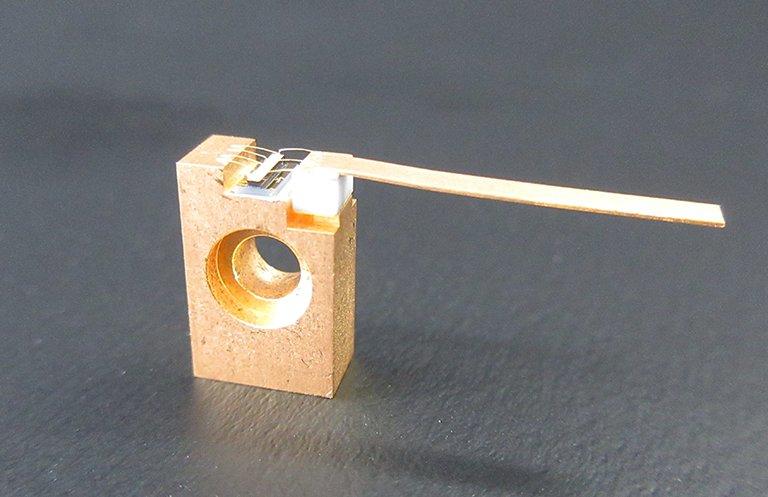Results of this research were published on November 2 (Thu) in the electronic version of the European Scientific Journal "Nanophotonics." This research and development work was supported by the MIC/SCOPE #195006001.
What are terahertz waves?
Terahertz (abbreviated THz: tera or T is a trillion) is a unit of frequency. Terahertz waves are electromagnetic waves near 300 μm that correspond to a frequency of 1 THz. The shorter-wavelength terahertz waves overlap with far-infrared light and the longer-wavelength waves overlap with millimeter waves. Terahertz waves have intermediate characteristics between those of light and radio waves, and the bandwidth at wavelengths longer than 300 μm and frequencies lower than 1 THz is called the sub-terahertz range. Terahertz waves appear promising for creating applications in various fields such as communications, chemical analysis, industry, and academic research, so R&D work on terahertz wave detectors and emitters is underway all across the world. Particularly in the sub-terahertz range, efforts have been made to develop optical devices and electronic devices. However, up until now it has been difficult to achieve both high performance and miniaturization from these devices, so creating useful applications in this range has not made satisfactory progress compared to light of other wavelengths.
Overview of research results
Last year, Hamamatsu Photonics developed a "terahertz nonlinear quantum cascade laser (QCL *1) that uses a unique anti-crossed dual-upper-state design (AnticrossDAUTM). This QCL produces two mid-infrared rays at different wavelengths within a range from 6 to 11 μm from a single semiconductor device and induces a nonlinear optical effect (*2) inside the device. The QCL in this way serves as a single compact semiconductor laser that operates at room temperature and generates terahertz waves up to a wavelength of 150 μm. To generate electromagnetic waves at even longer wavelengths in the sub-terahertz range, it is essential to produce and output two mid-infrared light rays at longer wavelength but this has been extremely difficult to achieve since the longer wavelength light is likely to be absorbed within the device.
Through this research, we investigated the characteristics of many QCLs to clarify wavelength conversion process in a terahertz nonlinear QCL and found that we can apply the theory of a nonlinear optical effect, called coherent optical rectification, which has not been evaluated before. By applying this theory to the wavelength conversion mechanism using the nonlinear optical effect, we optimized the anti-crossed dual-upper-state design to suppress the unwanted absorption of light inside the device, thus allowing output of the two mid-infrared light rays at longer wavelengths up to 13 to 14 μm and also increased the wavelength conversion efficiency. In this way, we succeeded in outputting terahertz waves at 450 μm in the terahertz range which is the world’s longest wavelength available from a single semiconductor laser operating at room temperature.
The results from this research will prove useful in applications such as quality testing and non-destructive inspection for identifying drugs and foods by measuring the difference in content of components that easily absorb electromagnetic waves in the sub-terahertz range. Possible applications also include submillimeter astronomy for studying the birth and formation process of stars by observing dust and gases in outer space that cannot be seen with visible light and infrared light. Moreover, since the wavelength of terahertz waves is shorter than radio waves commonly used for communication and propagate in the air to some extent, they can be used for high-speed and high-capacity communication over short distances such as within a home, office, or data center. Furthermore, in this work we have successfully fabricated QCLs producing terahertz waves at wavelengths of 130 μm, 210 μm and 270 μm. Currently, the longest-wavelength QCL demonstrated to date emits at 250 μm. However, the QCL requires cryogenic cooling below -200°C. Results from this research will lead to the development of semiconductor lasers that cover most of the terahertz range with a single device yet operate at room temperature.
In the future, we plan to develop devices with higher power output by increasing the terahertz wave output efficiency by improving the design of the QCL structure as well as applying a light out-coupling structure and appropriate material for the semiconductor substrate. We are also aiming to achieve CW (continuous wave) operation that produces a continuous light output at a constant intensity.
*1: Quantum cascade laser (QCL): A semiconductor light source capable of emitting high-power light in the mid-infrared to far-infrared wavelength range by using a light emitting layer with a unique structure different from conventional semiconductor lasers.
*2: Nonlinear optical effect: A phenomenon where light is generated at a wavelength equal to the difference in wavelength between two incident light rays.
Research background
Electromagnetic waves in the terahertz range situated between light and radio waves have a straight propagation property of light and a transmission property of radio waves, and so will be a promising tool in applications such as spectrophotometry, non-destructive inspection, and high-speed and high-capacity communication. Terahertz waves cause light to be absorbed while resonating with crystal structures and vibrations of biopolymers, and so can be used, for example, to acquire transmission images (like X-ray images) of drugs and foods by utilizing the difference in transmittance of the components they contain. Research on terahertz waves has been conducted based on both categories of optical devices such as semiconductor lasers and solid-state lasers and electronic devices such as diodes and transistors. However, terahertz waves have not been fully put to practical use because of difficulty in creating compact, portable terahertz wave detectors and emitters that operate at room temperature. In particular, there are no high-performance light sources that are compact and generate terahertz waves at a wavelength around 300 μm or in the sub-terahertz range. So there has been a huge demand for the development of such light sources.
Hamamatsu Photonics Deutschland GmbH
Arzberger Str. 10
82211 Herrsching am Ammersee
Telefon: +49 (8152) 375-0
Telefax: +49 (8152) 375-199
http://www.hamamatsu.com
Public Relations
Telefon: +49 (8152) 375-185
Fax: +49 (8152) 375-199
E-Mail: rfritsch@hamamatsu.de
![]()
